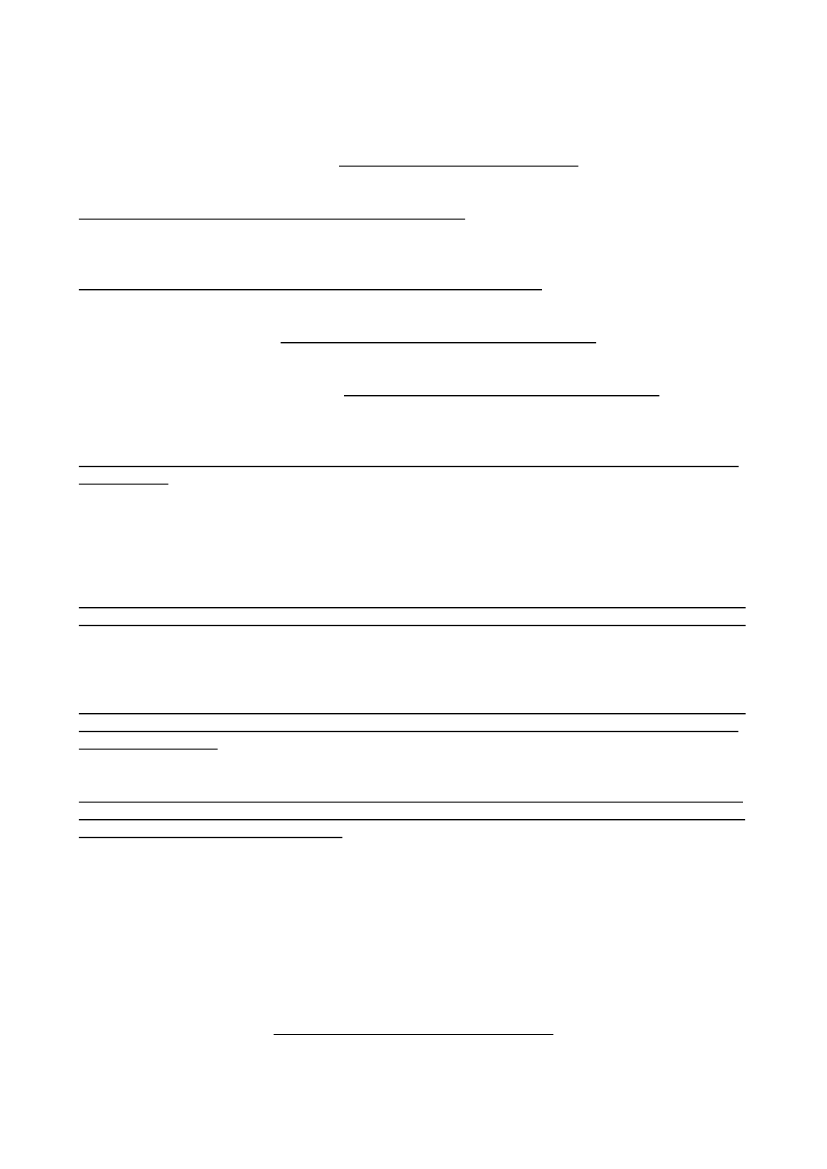NATO's Parlamentariske Forsamling 2010-11 (1. samling)
NPA Alm.del Bilag 5
Offentligt
ECONOMICS ANDSECURITY216 ESCTER 10 E bisOriginal: English
NATO Parliamentary Assembly
SUB-COMMITTEE ONTRANSATLANTIC ECONOMIC RELATIONS
GLOBAL RECESSION, POVERTY ANDINSECURITY IN THE DEVELOPING WORLD
REPORTJEPPEKOFOD (DENMARK)RAPPORTEUR
International Secretariat
13 November 2010
Assembly documents are available on its website, http://www.nato-pa.int
216 ESCTER 10 E bis
i
TABLE OF CONTENTS
I.II.III.IV.V.VI.
INTRODUCTION.........................................................................................................1ORIGINS OF THE CRISIS: FROM NORTH TO SOUTH, FROM BOOM TO BUST ...2COMMODITY AND FOOD PRICE MOVEMENTS ......................................................3INVESTMENT FLOWS ...............................................................................................5TRADE ........................................................................................................................6FISCAL AND MACROECONOMIC CHALLENGES ....................................................7
VII. POVERTY EFFECTS..................................................................................................8VIII. INTERNATIONAL COMMUNITY RESPONSE TO DEVELOPING COUNTRY NEEDS..................................................................................................................................10IX.X.XI.DEVELOPMENT ASSISTANCE ...............................................................................11CHINA IN AFRICA ....................................................................................................13CONCLUSION AND RECOMMENDATIONS............................................................15
BIBLIOGRAPHY ................................................................................................................19
216 ESCTER 10 E bis
1
I.
INTRODUCTION
1.The global financial and economic crisis has posed one of the greatest challenges tonational and international economic policymakers in decades. The crisis has adversely affectedthe lives of billions of people and is rife with critical economic, political and security implications ofboth a short- and long-term nature. It struck the developing world in a belated but neverthelessdevastating fashion, ultimately pushing millions of people into extreme poverty, reversing recentdevelopmental progress, and turning some voters in donor countries against developmentassistance. All of this unfolded at a particularly delicate moment of transition within this Alliance,which increasingly recognises that very serious humanitarian, environmental and securityproblems arise when states become fragile and poverty becomes endemic.2.The recent crisis is thus rife with serious security as well as economic and humanitarianimplications. It has rendered the lives of millions of people in the developing world even moreprecarious, but interestingly the international community seems to have responded with greateralacrity than in the past to their predicament. Globalisation has further clarified the stronginterdependencies between the developed and developing worlds. International policymakers arenow more responsive to the unique challenges that the developing world faces than in the past.That said, serious deficiencies in Western approaches to the developing world persist.3.Since the collapse of the Bretton Woods system, most financial crises have originated indeveloping countries and only belatedly, if at all, derailed growth in advanced countries. Thecurrent crisis is unique insofar as it began in the United States, the very heart of global capitalism,and only later spread to developing countries. Unsurprisingly, its impact has been moregeneralised and profound than previous crises arising out of Latin America or East Asia. Indeed, ittook nearly a year for the full impact of turmoil in American credit markets to strike fully emergingand developing countries. It did so, moreover, in a highly uneven fashion, an indication of theinherent diversity of this broad range of countries, some of which are rapidly catching up with thedeveloped north, while others languish in profound economic crisis and even state failure.4.The impacts of the crisis in developing countries have included massive job losses, reversemigration, falling wages, declining remittances and reduced capital inflows. Less developedcountries have additionally had to cope with unanticipated reductions in primary and secondaryschool enrolment, lower levels of healthcare, rising hunger and, in some cases, political instability.For the world’s poorest, the crisis has increased mortality rates due largely to malnutrition. Many ofthese effects have long-term implications. Declining primary school enrolment, malnutrition anddegrading health care standards can effectively stunt the growth and development of children,impairing them for the remainder of their lives and exacting a high toll over the long-term on thesocieties in which they live. Thus the impact of the current crisis on developing countries will, insome instances, have dire long-run effects on the social, economic and political landscape. In themost extreme cases, these could have serious security implications. This is one of severalimportant reasons why the international community must maintain its long-term commitments tohelping developing countries create the conditions for genuine and sustainable development.5.The most acute phase of the economic crisis has now passed, but, the damage to thedeveloping world is real and will have long-term consequences. Surprisingly though, the impacthas generally been less catastrophic than many economists and development experts had initiallypredicted. The reasons are complex and varied but certainly include the rapid internationalresponse to the crisis with key guiding roles played by the G-20, the IMF and the World Bank. Butperhaps the most important factor has been the impressive reforms many developing countriesundertook over the past decade which left them better prepared to cope with the global downturn.A number of emerging countries have been pursuing sounder macro- and micro-economic policiesthat have rendered their financial and commercial systems more robust than in the past. Improvedgovernance, regulation, and transparency have thus left many emerging and developing countries
216 ESCTER 10 E bis
2
better prepared to weather external shocks while paving the way to a relatively swift return togrowth and stability.
II.
ORIGINS OF THE CRISIS: FROM NORTH TO SOUTH, FROM BOOM TO BUST
6.The financial crisis triggered a contraction of global trade and output unprecedented in thepost-World War II era. Although, the contraction was led by the steep declines in industrialisedeconomies, many developing countries suffered from falling commercial exchange. Yet, by 2009,many of these developing countries were already achieving positive growth rates. While there ismuch variation across and within the regions, growth rates across the developing world generallyfall below trend. Latin America and the Central Asia-Emerging Europe region saw sharpcontractions of –2.6% and –6.2%, respectively. The other four developing regions each sawpositive growth. Sub-Saharan Africa and the North African-Middle East regions grew more slowlyat 1.1% and 2.9%, respectively. In contrast, emerging Asia again led the world in 2009, withSouth Asia growing by 5.7% and East Asia and the Pacific obtaining real GDP growth of6.8% (WB [World Bank], GEP). These figures include the emerging global powers of China andIndia, which were, yet again, two of the world’s best performing economies. Their size obviouslyskews the statistics. If one excludes these giants from the calculation, the developing worldcontracted by –2.2% in 2009, as against 1.2% growth when China and India are included.Nonetheless, it is clear that the global South fared much better than the North during this latestcrisis and has emerged more quickly from it. Still, millions of people in developing countries havesuffered incomparably due to their greater level of vulnerability prior to the crisis.7.The recent recession must be considered in light of a decade of strong growth prior to theglobal turmoil. On average, developing economies grew, in real terms, by approximately 7% eachyear of the boom from 2003 to 2007. While much of the expansion was driven by Chinese andIndian growth rates at 11% and 9% respectively, virtually all countries performed significantlybetter than during the 1990s and early 2000s. Except for emerging Eastern Europe, inflation ratesin emerging economies in 2007 hovered around 6% during a period of large capital inflows andexpanding credit. Again excepting Eastern Europe, current account deficits and gross debt levelsin developing and emerging economies generally remained modest and sustainable.8.While millions in the Least Developed Countries (LDCs) have suffered greatly throughoutthis latest global crisis, many of the investments made during the boom will yield long-termbenefits. Indeed, unlike previous investment booms (such as in the mid-1990s) a much greatershare of the capital inflows to developing countries have gone into fixed capital formation ratherthan to one-off merger and acquisitions, short-term debt financing or to underwrite excessiveconsumption (UNCTAD, 2009). These investments have introduced a greater degree of resiliencein many developing countries, helping them to weather the recent financial storm.9.We now know that the easing of global credit conditions from 2003 onwards was clearlyunsustainable. Yet, the boost of relatively cheap capital to developing economies helped a numberof middle-income countries break out of a ‘capital trap’. From 2000 to 2007 net capital inflows tothe developing world quintupled, while spreads on foreign debt fell from 6.56% to 1.68%. Theseinflows coupled with strong institutional and policy reform have placed many developing countrieson a higher capital-output trajectory, which increases their prospects for long-term growth. Anincreasing capital-output ratio obviously reflects a country’s improving economic potential. Indeed,while rates of growth in GDP were undoubtedly impressive during the boom years, even morepromising was the increase inpotentialoutput. The crisis, of course, has significantly reducedinternational capital flows while increasing the cost of borrowing; the growth of potential output hasslowed accordingly. Developing countries, however, are clearly in better shape than they were adecade ago. As the potential output of the developing world soared during the boom andretreated in the crisis, the percentage point decrease in potential output growth (approximately
216 ESCTER 10 E bis
3
0.2 to 0.7 percentage points lower per annum) is less than the boom period’s increase of1.5 percentage points over the pre-boom period from 1995 to 2002 (WB, 2010). This suggeststhat the developing world has clearly taken a step forward over the course of this recent globalbusiness cycle.10. The global credit boom from 2003 to 2007 was driven by a fatal combination of excessliquidity, macro-economic imbalances and poor financial regulation in the world’s major financialcentres. For its part, the developing world benefited from this rise in liquidity and enjoyed asignificant increase in capital inflows during the boom (World Bank, 2010). Properly handling thisinflow required an important degree of banking reform in many countries – increasing theircapacity for what is known as ‘domestic intermediation’ of capital inflows from abroad. Risingforeign investment is generally funnelled through domestic banking institutions. Mounting capitalflows, in turn, helped to increase the size, liquidity base and, ultimately, the capacity of theseinstitutions.11. Varying regulatory environments constitutes a principal difference among developingcountries. Those countries with more sophisticated regulatory capacities have been better able toallocate capital inflows toward productive investments. In other words, capital has tended to beput to the best use in those countries where sound governance structures and practices are inplace (World Bank, 2010).12. There are, however, important exceptions to this narrative of progress. Central Asia andparts of emerging Europe, for example, followed unsustainable financial and fiscal policies duringthe run-up to the crisis. The numbers suggest that capital inflows to these regions helpedunderwrite unsustainable levels of consumption, while government deficits run during these boomyears provided little room for manoeuvre once the good times ended (NATO PA 2010 Report,“The Impact of the Financial Crisis on Central and Eastern Europe” [217 ESCEW 10 E]). At thesame time, the highly diverse group of Least Developed Countries continue to confront acute andpersistent development challenges, and many are plagued by the kind of insecurity that makesdevelopment nearly impossible. The unique plight of LDCs is explored below.
III.
COMMODITY AND FOOD PRICE MOVEMENTS
13. The developmental challenges now facing the global South are obviously complex andmyriad. The recent financial crisis is only a small part of the problem. Perhaps even moreconsequential, in some respects, was the preceding food crisis that had already begun to wreakhavoc on the lives of millions of people prior to the global economic downturn. The developingworld’s remarkable growth after 2003 also boosted global demand for a broad range ofcommodities. The rapid expansion of China and India’s middle classes has been particularlysignificant in this regard. Rising demand for food, and particularly for protein rich food, has beenone factor generating pressure on primary commodity supplies. Commodity price rises from 2003to 2008 were the most acute in over a century in terms of degree, duration and the number ofcommodity groups affected (World Bank, 2009). During this period, real non-energy commodityprices doubled and real energy prices rose 170% (World Bank, 2010). In developing countries,these price rises struck the poor particularly hard, resulting in some cases in increasedmalnourishment and even political instability.14. Commodity price changes can have sharp effects on developing country growth as manydeveloping economies rely heavily on the export of a handful of commodities. Price changes in justa few key commodities can therefore have serious impacts on the foreign exchange earnings ofundiversified economies. Managing an economy that is driven by commodity sales thus posesunique challenges. Adding to this particular challenge is the growing interrelation between fuel andfood supply and demand. Petroleum products have long been key agricultural inputs and are used
216 ESCTER 10 E bis
4
to make fertilisers, to operate farm equipment and to move product to world markets. But the linkhas been tightened recently as grain-based bio-fuel has become an important and highlysubsidised petroleum substitute. Thus as energy prices rise, they increasingly drag along globalfood prices, particularly as arable land is increasingly diverted to fuel production. Moreover, recentdroughts in East Africa and Oceania led to poor harvests that further tightened global foodsupplies. Of course, these price movements have varied effects on different economies, withoil-exporters, for example, greatly benefiting from soaring fuel prices.15. Ironically, hundreds of millions of small farmers and farm labourers were unable to capturethe benefit of rising food prices. Because the prices of the key inputs of energy and fertilisers rosein tandem with food price, small farmers often failed to achieve higher income on their production(FAO, 2009). Wages for the rural landless and earnings for small farmers stagnated while thecost of their basic foodstuffs soared. Indeed, after years of steady increase, prices of wheat, riceand soybeans suddenly jumped 2- to 3-fold in the first quarter of 2008 (World Bank, 2010).Obviously, food expenditures consume a far higher share of individual income in poor countriesthan in developed ones. Doubling or tripling these costs can thus quickly push millions of familiesinto destitution.16. These substantial price increases proved short-lived as the global financial crisis began toundercut demand. Energy demand also declined precipitously both as a response to soaringprices and because consumer income was falling in many energy intensive economies. Fallingenergy prices also eased pressure on food prices, although food prices did not fall to the sameextent as energy prices due to continuing market bottlenecks. In the autumn of 2008, followingthe collapse of Lehman Brothers, commodity prices plunged with a momentum comparable only tothe price increases of that spring. From July 2008 to February 2009, agricultural prices declined by30%, metals fell by over 50% and energy prices plummeted by an incredible two-thirds inUS$ terms (World Bank, 2010a). These declines, however, were often not translated intomatching declines in local prices for many countries (World Bank, 2009b). Since the first quarterof 2009, prices began to edge upwards as economic activity recovered. This immediately triggeredconcerns about a new rise in food prices (World Bank, 2009b).17. A recent joint FAO, OECD report (FAO, 2010) suggests that over the next decade coarsegrain prices will, in real inflation-adjusted terms, rise by 15 to 40% above the 1997-2006 averages,while dairy and vegetable oils may well rise by over 40%. This summer’s drought and forest firesin Russia, Ukraine and Kazakhstan led to the quickest increase in grain prices in three decades,with European wheat prices nearly doubling from 120€/tonne in April 2010 to a peak of 220€/tonnein early August 2010 (FT, 2010c). Russia’s subsequent restrictions on wheat exports onlyheightened market uncertainty and price volatility. At the same time though, the FAO hasestimated the number of hungry people in the world will drop by 9.6% in 2010 to 925 million, thefirst decline in 15 years. This is due to the improving economic climate in many developingcountries. This figure, however, was produced prior the Russian action (Kilman). For the momentthough, senior FAO economists are convinced that renewed growth is helping to reduce hungerlevels. World wheat stocks are very high due to record harvests in 2008 and 2009 and, in FAO’sestimation, today’s price volatility is not likely to result in the kind of price surge that created the2007 crisis. Once again though the situation could vary significantly across regions, and someforesee far more trouble in Africa than in Asia and Latin America.18. As suggested above, these price movements have had varying effects on differentdeveloping countries. Of course, the real impact hinges on whether countries are net importers orexporters of a given commodity. The intensity of the domestic use of that commodity and/or therelative weight of that commodity in overall exports and GDP are also important. Another factor iswhether or not the income of a broad share of the population is derived in one way or another fromthe sale of a particular commodity or a basket of commodities or, in contrast, if income is highlyconcentrated in the hands of a narrow elite. The capacity of a given developing country to convert
216 ESCTER 10 E bis
5
commodities into intermediary or finished products and thus to derive income from higher value-added activities is also of great consequence. Finally, although many developing countries relyheavily on the exports of particular commodities, neither producers nor consumers benefit fromextreme price volatility because this fosters the kind of uncertainty that discourages economicactivity and particularly investment.
IV.
INVESTMENT FLOWS
19. The primary transmission mode of the global crisis was through the international financialsystem. The rapid increases in finance flowing to the developing world during the boom and themarked reversal during the global recession are central elements of this narrative. Over the past10 years, the composition of international capital flows to the developing work has changedmarkedly (BIS, 2009). In the 1980s and 1990s, capital inflows to developing countries largelyunderwrote short-term debt instrument which were often used to finance fiscal deficits or to sustainconsumption rather than to bolster domestic capital formation (BIS, Turner 1995). As suggestedabove, over the past decade inflowing capital was far more likely to underwrite productiveinvestments.20. The level of net capital inflows to developing countries, in aggregate, remained below 1% ofGDP until the late 1980s. Over the next 10 to 15 years, however, capital inflows more thandoubled, although not all countries benefited equally (IMF, WDI database). Low-income countries(LICs) received net inflows of just 0.24% of GDP in 1988. Between 1997 and 2005 this figure roseto roughly 2% of GDP, subsequently rising to 2.87% in 2006 and 4.3% in 2007. From 2000 to2007 investment as a percentage of GDP rose between 32 to 38% in East Asia, and 23 to 34% inSouth Asia, again reflecting very high investment rates in China and India in particular. While it isdifficult to determine the actual productivity of these investments, rapidly expanding exports andindustry’s rising share of value-added production in total output suggests that these funds werelargely being put to productive use, although bad lending has certainly been a problem in somecountries including China (IMF, WDI database).21. In 2009 net private capital flows to the global south fell by US$795 billion, a 70% drop fromthe 2007 historic peak (World Bank, 2010). However, the magnitude of the reversal was far lessthan observed in previous crises and did not completely arrest capital flows to most regions.While some countries lost access to international capital markets, more advanced emergingeconomies retained their capacity to issue international bonds and to win subscribers. Amazingly,in 2009 corporate bond issued by developing countries reached US$109 billion, an increase ofnearly US$5 billion over 2008, a reflection of investor confidence even during the downturn.Turkey and the Philippines, for example, raised US$2 billion and US$1.5 billion in 2009,respectively (World Bank, 2010). Thus, despite the drastic fall in global investment rates over thepast two years the ‘flight to quality’ dynamic was certainly less pronounced in comparison toprevious crises. One could alternatively argue that a number of developing countries have simplybecome quality destinations for investors.22. Investment levels in developing and emerging economies are also expected to reboundmore quickly than in advanced economies. UNCTAD (2009) has suggested that private capitalflows to the developing world should grow quickly in 2010 and 2011, and might even match the2007 peak figures by 2012. The dramatic expansion of domestic savings and the development oflocal capital markets during the boom have also helped compensate for declines in foreigninvestment. The World Bank reports that in the first 11 months of 2009, new equity issuances inemerging economies reached US$98 billion, up from US$66 billion over the same period of 2008.
216 ESCTER 10 E bis
6
V.
TRADE
23. The profound impact of the crisis on global trade flows has been widely reported. Fallinginternational commercial activity has been one of the primary vehicles for spreading the impact ofthe crisis beyond the developed world. Throughout the global economic expansion earlier thisdecade, exports from developing countries rose precipitously in both value and quantity(World Bank, 2010). Indeed, developing country exports grew approximately four times faster thandid advanced economy imports (WB Briefing Brussels). Such export growth, moreover, did notsimply reflect soaring consumption in the developed world. Analysts suggest that developingcountry exports, in fact, have begun to displace Western exports (World Bank, 2010b). In 2001developed country exports accounted for 66.5% of the world’s total. By 2008 this share had fallento 56.6% (UNCTAD, 2009). These numbers point to growing “south-south” trade amongdeveloping countries. Rather than capitalising on lower-wage rates alone, manufacturers in themore dynamic developing countries world have significantly improved total factor productivity overthe past decade and are proving formidable competitors with developed country producers.Admittedly, there are other important factors behind this shift, including the lagged effects oflower-tariff rates and increasing international investment. However, increased productivity indeveloping countries is the driving force behind these significant changes.24. Growing productivity, however, is far more evident in middle-income rather than in the LeastDeveloped Countries. The latter often lack the infrastructure to exploit trade opportunities. Theydo not enjoy easy access to credit, and often are effectively locked out of international marketsdue to protectionist policies, particularly for agricultural goods. Even in low value-added exportsectors like agricultural commodities, LDCs have been losing ground to low- and middle-incomedeveloping countries (UNCTAD, 2009). The 49 LDCs are not engaged in high-value primarycommodity production and are often structurally unable to exploit opportunities in the internationaleconomy. Support from the international community to help build trade-generating infrastructurewill therefore remain a vital means to help LDCs break out from the underdevelopment trap. In thecurrent economic climate, however, there are signs that several key donor countries are losing,the will to underwrite such efforts. Thus, on the trade front, the gap is widening between therelatively dynamic emerging nations of the global South and those poorer countries that confrontan array of structural, financial, political and security challenges that make it inordinately difficult tomove their goods to global and even to regional markets.25. Tariff rates for goods in which developed countries have a comparative advantage havefallen to the low single digits but remain very high on those products that poor countries export.There were promises made in the 2000 Millennium Declaration to provide duty-free quota-freemarket access for virtually all exports from the leading developed countries. This goal wasreaffirmed at the 2005 WTO Ministerial Conference, but little action has since been taken.Ministers at that meeting also called on emerging countries to extend LDCs open market access.One problem is that the Doha Round has stalled and will likely not be concluded for some time.Today high levels of agricultural protection in North America and Europe only compound theproblems these countries confront. But there is also a dense web of south-south trade restrictionsthat penalise developing countries (World Bank, 2010c). On the other hand, the internationalcommunity has so far largely resisted the temptation to respond to the economic downturn byraising tariff and non-tariff barriers. During the 1930s the great economic powers engaged in a“beggar thy neighbour” tariff war that exacted a terrible toll on all economies. Opening trade ratherthan restricting it is the best means to respond to falling global economic growth.26. At Gleneagles in 2005 the G-8 called for the successful completion of the DohaDevelopment Round; yet those negotiations came to a crashing halt in 2006. They have sinceresumed, but the gaps in negotiating positions remain formidable (UNCTAD/WTO, 2009). Anybreakthrough in Geneva would create some optimism about a trade-driven boost to the globaleconomy, but the prospects for this are not particularly bright. The first round of serious
216 ESCTER 10 E bis
7
negotiations were held at the end of March 2010, but no tangible framework for resolvingoutstanding disagreements has yet emerged. Apart from continued calls for more concertednegotiations, there have been no further signs of progress. To be sure the complexities aredaunting, but the benefits of a timely agreement far outweigh the concessions that will be neededto achieve a breakthrough.
VI.
FISCAL AND MACROECONOMIC CHALLENGES
27. As a result of the global economic downturn, the World Bank’s initial 2007 projection for theglobal output level in 2011 will now likely only be reached in 2014 (IMF, WEO 2009). Meanwhileadvanced economies are expected to grow, in real terms, by approximately 12% from 2006 to2014 – a level previously expected to be achieved by 2010. The World Bank estimates that therate of per annum growth of potential output for developing countries will be 0.2 and0.7 percentage points less over the next five years than had previously been expected. Thistranslates into a fall in the long-run level of potential output of between 3.4% and 8.0% against thepre-crisis scenario (World Bank, 2010).28. Rising capital costs are going to continue to pose problems. The World Bank (2010)estimates that: “The borrowing costs developing countries face could rise by between 110 and220 basis points compared with their boom-period levels”. In practical terms, this suggests thatsome developing country governments will have to slash core spending programmes that havelong been seen as vital planks for long-term development. With debt levels soaring in the OECD,higher developed country borrowing could begin to crowd out developing country borrowing. Mostdeveloping countries entered the current crisis with fiscal deficits made all the more burdensomeby exploding food and fuel prices. All of these factors will add to the cost of debt financing.29. A key question for developed economies over the next two to six quarters will be how andwhen to unravel the fiscal and monetary supports that were put in place at the height of the crisis.Reining in the loose monetary policy will invariably result in interest rate hikes. This is unavoidablebecause exceptionally low nominal interest rates (below 1% in real terms) provide little room formonetary responses to future downturns; that space must soon be created or Central Banks risklosing control of a critical monetary tool. Yet, even in economies where loosened monetary policywas not part of the crisis response, comparatively higher interest rates could attract destabilisingcapital flows, particularly in those countries maintaining open capital accounts. Therefore, inconsidering the return to normal monetary operations, developing countries must be conscious ofboth the effects on local credit conditions and of their exposure to developments in large creditmarkets in the advanced economies. At the G-20 meeting in June 2010 the consensus view wasthat consolidation efforts must soon begin to proceed, but there was little guidance as to when thisshould begin. In fact, it is already underway. But if Western fiscal tightening unfolds prematurely,this could slow down export markets for developing countries. An uneven and unco-ordinatedtightening of monetary policy could generate destabilising ‘carry trade’ or speculative financialflows. This is all generally discussed as a matter for Western governments, but developingcountries are hardly insulated from these developments.30. Not surprisingly, the current crisis has also opened an important debate about globalfinancial architecture. The desirability of an open trading regime represents the one area whereconsensus reigns among economists. But as suggested above, the Doha Round has all but stalled– tied-up in seemingly interminable battles over agricultural subsidies and market opening(Bhagwati, 2009). There is far less consensus among economists about matters pertaining tofinancial liberalisation and capital account openness than there is about the virtues of free trade(WSJ, 2010, WB, GEP 2010). Even the IMF, long a supporter of unhindered capital mobility, nowimplicitly recognises the potential need for capital controls in countries with under-developedfinancial sectors (IMF, 2010).
216 ESCTER 10 E bis
8
31. Indeed, under-regulated financial markets have been seen as one of the key causes of theglobal economic crisis (Baily). However, the impact of financial liberalisation on economic stabilityin developing countries remains a source of some contention. Since the Asian financial crisis ofthe 1990s, economists have had to weigh the risks of moving too early to liberalise the capitalaccount against the possibility of cutting developing countries off from potential capital inflows.That debate has re-emerged as a result of the current crisis, and more economists andpolicymakers have begun to recognise the risks of premature financial opening to so-called“hot money”, particularly in the absence of a robust regulatory framework. It is thus far lesscommon today to hear economists arguing for full capital market liberalisation in developingcountries.
VII. POVERTY EFFECTS32. It is estimated that the crisis has pushed an additional 64 million people into absolute poverty(World Bank, GEP). Another study found that in Africa some 30,000 to 50,000 children under theage of five died in 2009 due to the impact of the global economic crisis (Friedman and Schady,2009). As always, it is the poorest segments of society that are at the greatest risk of falling intoextreme poverty in a downturn. The impacts of extreme poverty can be long-lasting, and it can bevery difficult to move back above the poverty line after falling below it (Ravallion, 2008). Gettingthe millions that have fallen below the poverty line out of that predicament now poses one of thegreatest challenges for national and international policymakers.33. As suggested above, the first signs of economic difficulties in the developing world did notstart with the crash of Lehman Brothers, but rather when commodity prices began to soar. Manypoor families and farmers found themselves in a weaker position as a result. In Kenya farm-gateprices remained flat while the cost of fertiliser tripled in a six-month period. Rising transportationcosts, in turn, blunted incentives for boosting food production (FAO, 2009). Malnutrition levelswere thus already on the rise in 2008 before the global recession struck. Indeed, between 2004and 2008 theproportionof chronically hungry people in the world increased for the first time since1970 when records began – a trend that only worsened in 2009 (FAO, 2009).34. The UN’s Food and Agricultural Organisation (FAO) estimates that the number ofundernourished people worldwide rose from 915 million in 2008 to 1.02 billion in 2009 – thehighest numbers recorded since 1970. Indeed, global under-nourishment had consistently fallen inabsolute terms from 1970 to 1995. But, it subsequently began to rise despite increasing GDPgrowth rates in developing countries – a reflection of the rising inequality that often accompanieseconomic growth. The UN’s Standing Committee on Nutrition (UNSCN) projects that the numberof underweight children below the age of five will increase to 143 million, 5 million more than if the2007 projections had remained constant. Similarly, 50 million pregnant women suffer fromanaemia (UNSCN, 2010), which often leads to serious life-long mental and physical challenges forthese soon-to-be born children. Certainly, the consequences of today’s malnutrition can beexpected to endure for several generations in both obvious and in subtler but equally devastatingways.35. The decline or loss of household income has also aggravated the situation for millions ofimpoverished people. The International Labour Organisation (ILO) reports that, after four years ofabsolute decline, the total number of unemployed people in 2008 increased by 7.2 million, from177.7 to 184.9 million. Its estimate for 2010 worldwide unemployment ranges from 201.9 million to221.2 million. Global unemployment rate will likely reach 6.6% in 2010, with a rate of 13.4% for theworld’s youth (ILO, 2010). While the jobs crisis in the developing world is still unfolding, it is clearthat many urban labourers are being pushed into informal markets (where wages are lower) or arebeing compelled to return to their rural homelands to work in the marginal and already
216 ESCTER 10 E bis
9
over-employed agricultural sectors. According to the ILO, “between 40 and 50% of the world’sworking men and women in 2009 are not expected to earn enough to lift themselves and theirfamilies above the US$2 a day per person poverty line” (ILO, 2009). The harsh reality ofinadequate food and rising unemployment will pose serious challenges to social, economic andsecurity stability.36. Many developing countries are dependent on food imports (FAO, 2009). This obviouslyincreases their need to generate foreign exchange through exports, foreign investment, OfficialDevelopment Assistance (ODA) and remittances. Of these, FDI has declined the most while ODAand remittance flows have remained somewhat more stable. While remittances have traditionallyassumed counter-cyclical functions during difficult economic times, this crisis has hit labour-importing countries in Europe, North America and the Gulf Region particularly hard and therebyreduced global remittance earnings. Remittance flows fell from a historic high in 2007 ofUS$338 billion to US$317 in 2008, a drop of 6.1%. There is even evidence of ‘reverseremittances’ from Mexico to the United States before the recessionary impact of the crisis struckMexico. The World Bank expects remittance flows to recover only slightly in 2010 and 2011, asindustrialised countries struggle to revive their economies in the face of massive fiscal shortfalls(World Bank, 2009). Rising anti-immigration sentiments in the United States and in Europe couldadd further political complications, unless governments adopt more realistic immigration policiesthat better align regulations with economic and social reality.37. Even before the crisis, it had become evident that most Millennium Development Goals(MDGs) would not be achieved by 2015. Upon entering the crisis, 40% of developing countrieswere highly exposed to poverty effects of food and energy price increases (with both declininggrowth rates and high levels of poverty), while most others were moderately exposed (World Bank,2009c). Yet, high growth rates achieved during the boom had lifted millions out of poverty andseemed to have put the world on a path toward halving global poverty by 2015 (MDG 1).Unfortunately, the earlier food and fuel crises “pushed an estimated 160 million to 200 million morepeople into extreme poverty” (World Bank, 2009c). As trade and GDP rebound, fewer people willrise above the poverty line than the number pushed below it as a result of the crisis at least overthe short-term. The concern is that millions have essentially been caught in a poverty trap thatcould vitiate the benefits of revived global growth.38. Preliminary studies suggest that the impact of the crisis will ultimately cause the death of200,000 to 400,000 infants over the next five years (World Bank, 2009c), reversing progresstoward the goal of reducing the mortality rate by two-thirds (MDG 4). Education will also beadversely affected and will very likely reduce school enrolment. Girls’ school enrolment will fallmore than that of boys, similarly mitigating progress towards gender equality in education(MDG 3.1). The consequences for the next generation’s productivity, their mental faculties andphysical health are unquantifiable but malnutrition and extreme poverty will likely have aconsequential impact on all of these indicators.39. It should be noted, however, that the central Millennium Development Goal of reducingpoverty levels by half from their 1990 level by 2015 remains on track (World Bank 2010). But,progress toward this goal is almost entirely due to the stunning growth of the Chinese and Indianeconomies over the past decade, where tens of millions have been lifted out of poverty. But whilegrowth in East and South Asia is, on the whole, impressive, the performance in sub-SaharanAfrica has lagged significantly behind. Based on pre-crisis trends, even extending the timeline byfive years to 2020 would not provide sufficient time to reduce poverty by half in sub-Saharan Africa(World Bank, 2010). It should be noted here that 31 of the 49 LDCs are located in sub-SaharanAfrica. In these countries, by definition, the average income per capita is below US$905(PPP [Purchasing Power Parity] GNI). School enrolment and adult literacy levels are unacceptablylow. Child mortality and malnutrition levels rates are high and national economies remain fragile(UNCTAD, 2009).
216 ESCTER 10 E bis
10
40. Most LDCs are in sub-Saharan Africa, with two in the Middle East and North Africa, one inLatin America, five in South Asia and six in East Asia and the Pacific. LDCs differ widely in termsof their size, level of democratisation and economic and political challenges. They remain largelyisolated from international capital markets, which, while providing some insulation from thefinancial crisis has also reduced their capacity to underwrite desperately needed investments.Falling aid levels and remittances, and the collapse of trade have worsened the plight of millions inthe LDCs. Even during the boom, LDCs were nowhere near the trend lines needed to halvepoverty by 2015. These economies are generally not sufficiently diversified and remain vulnerableto the price shifts of a few key commodities. Governments from these countries have almost nofiscal leeway to engage in counter-cyclical spending to bolster demand on the downswing and arethus denied a critical tool for managing external shocks (UNCTAD, 2009).41. It is nonetheless important to recognise that for much of the past decade many LDCsexperienced positive growth rates. This growth can be attributed to a number of factors including:high remittances, unprecedented rates of gross capital formation, rising commodity prices andimportant influxes of increasingly better-calibrated ODA. In 2007 remittances accounted for3.9% of LDCs’ gross domestic product, while official development assistance accounted for 8.0%;both proportions were below their recent peaks of 4.2% (2004) and 11.5% (2003), respectively(WDI database). Neither of these factors can be ignored, and a significant retrenchment of eitherwould compound the already precarious situation in these 49 countries.42. The challenges confronting the poorest sixth of the world transcend any fallout from therecent financial crisis. The sources of their worsening plight include the structure of global foodmarkets, trade protectionism, war and instability, the unique problems of fragile states, poorgovernance and infrastructure, the uneven distribution of wealth and chronic unemployment. Therelatively strong performance of many developing countries in this crisis has thus not significantlyameliorated conditions in the poorest countries. Failing states are a particular concern. A countrylike Somalia, for example, where the central state has essentially lost control of the hinterland,poses a threat to regional stability at the same time that its people are enduring a humanitariantragedy (Marozzi).43. This is precisely why it is so important to maintain Western aid programmes despite seriousfiscal pressures. The provision of technical and financial support for badly needed infrastructure inLDCs (and in middle-income countries), for example, will help these countries generate strongergrowth employment and business opportunities. This is as much a security imperative as it is ahumanitarian challenge. Helping to create economic opportunities for the most vulnerable willcontinue to remain a vital pillar of global security.
VIII. INTERNATIONALNEEDS
COMMUNITY RESPONSE
TO
DEVELOPING
COUNTRY
44. The international community’s reaction to the crisis in developing countries was relativelyswift. This proved particularly helpful as did the fact that the crisis struck the developing world in adelayed fashion, giving policymakers time to prepare for the inevitable knock-on effects of theWall Street crisis. Concerted international action helped prevent panic and kept solvent manyvulnerable countries, which lacked the fiscal space to respond on their own. Government leadersmeeting at the April 2009 G-20 London Summit, for example, agreed to a 200% increase in theIMF resources - from US$250 billion to US$750 billion, a sum which included special drawingrights (SDR) facilities of US$250 billion. It also deemed that US$6 billion generated through IMFgold sale proceeds should be lent to the world’s poorest nations with an additional US$100 billionplaced at the disposal of multilateral development banks. For its part, the IMF has reformed itslending bodies, including the introduction of a rapid response facility known as the ‘flexible credit
216 ESCTER 10 E bis
11
line’. This is a vehicle for providing emergency financing to countries facing strong macroeconomicand financial pressures. Moreover, the G7 nations pledged to underwrite debt relief, improvementsin educational capacity, and water and sanitation services. They also promised greater investmentin agriculture and more market access for sub-Saharan African producers.45. From the early 1980s until very recently, the IMF required developing countries confrontingfinancial crises to boost interest rates, slash deficits, reduce trade barriers and devalue currenciesin order to qualify for emergency funding. It was a one-size-fits-all policy response to financialcrisis, which did not always work as planned. The Asian Financial crisis in the late 1990sdemonstrated that such prescriptions were not necessarily appropriate. Since then, a number ofAsian countries have chosen to hoard their own capital in order to garner the resources needed tomanage a global or regional downturn rather than to have to turn to the IMF and its set of policyprescriptions. Yet the IMF has also learned from its mistakes and has developed new tools to helpdeveloping countries survive the financial and commercial shocks of the past two years.Importantly, it has not reverted to simple pleas for austere monetary and fiscal policies, which canhave very adverse effects on critical social and development spending (Davis,28 September 2009). The Fund has also sought to restructure its own operations in such a way asto improve its crisis prevention and crisis response capacities. It is seeking to ease some of thetensions arising out of the high demand for global liquidity by emerging market economies andtheir dependence on the stability of a very limited number of suppliers of this liquidity. Achievingthis particular goal ranks among the central financial challenges to the international system today(IMF Survey, 26 February 2010).46. This summer the IMF announced that it would further expand the kinds of loans it makes tohelp developing countries on the cusp of financial crisis. This substantial “precautionary creditline” for as much as five times a country’s normal quota would be extended to countries pursuingsound macro-economic policies but facing potential future difficulties. The IMF would, however,impose conditions on recipients which would be designed to correct structural deficiencies in areaslike trade and fiscal policy, monetary policy, financial regulation and transparency. One problem isthat recipients of these kinds of loans might feel stigmatised in global markets, and this, of course,has a price. Three countries have so far taken out these flexible credit lines: Mexico, Columbia andPoland. The IMF is also developing a “global stabilisation mechanism”, which would be availablefor groups of countries, thereby reducing the potential stigma of IMF borrowing. This idea hasbeen pushed by Asian nations which remain very concerned about IMF lending and conditionality(Davis, 31 August 2010).47. For its part, the World Bank ramped up lending to middle income nations to a recordUS$33 billion in FY09 to 30 June as part of a three-year US$100 billion-dollar burst of lending tosupport global demand. It also launched an initiative to raise funds to buy distressed assets frombanks in emerging and developing markets to help them clean up their balance sheets and to freeup credit flows. This was in response to the problem that rising losses on loans were strainingbank balance sheets. The International Finance Corporation (the World Bank’s private sectorwing) will commit US$1.5 billion to this effort and hopes to raise an additional US$4 billion. Therehas been uncertainty about future financing capacity for the World Bank. While developingnations unanimously support a capital increase for the World Bank, some in the developed worldhave been highly reluctant to endorse this course (Guha, Strauss and Giles).
IX.
DEVELOPMENT ASSISTANCE
48. Although rapidly developing emerging economies have largely managed to wean themselvesfrom development assistance, LDCs, in particularly, remain highly dependent on external supportto underwrite vital infrastructure development, capacity building and human development. The11 most aid-dependent LDCs in sub-Saharan Africa rely on foreign grants for approximately
216 ESCTER 10 E bis
12
25% to 50% of government expenditure (UNCTAD, 2009). The problem today is that fiscalproblems in donor countries are putting enormous pressure on aid budgets. This, in turn, couldlead to reduced expenditures on infrastructure, education and healthcare with long-term andadverse effects on the poorest developing countries.49. It is becoming increasingly clear that because of the global financial and economic crisis andfaltering political will in this harsh economic climate, the aid targets laid out at Gleneagles will notbe met. The DAC (Development Assistance Committee)-EU 16 and the seven non-EU membersare currently not meeting collective commitments solemnly undertaken at that meeting. Onerecent OECD DAC study suggested that overseas aid has fallen US$21 billion short of thepromises made at the Gleneagles Summit five years ago. Seven of the 23 OECD DAC membercountries have reduced aid levels due to domestic budgetary pressures (NATO PA OECDmeeting, February 2010). DAC figures also show that aid has increased by 35% since 2004; butthere is still a large and persistent gap between aid promised and actual aid delivered –US$17 billion of this shortfall is due to unmet promises from donor governments; but US$4 billionof the deficit stems from aid pledges linked to set percentages of donor country income. In thesecases, the global economic downturn has simply shrunk the size of certain donor economies thatset aid levels in this manner, and this, in turn, has triggered reductions in development assistance.50. Although most donor countries are slated to meet their aid commitments, theunderperformance of several large donors will generate a significant shortfall in overall promisedaid. In 2005, the 15 countries, members of both the EU and the DAC, committed to reach aminimum Official Development Assistance country target in 2010 of 0.51% of their Gross NationalIncome (GNI is a measure of a country’s annual income based on the total value of goods andservices produced within its territory, plus net income received from other countries in such formsas interest payments and dividends). Several countries will surpass that goal: Sweden, with theworld’s highest ODA as a percentage of its GNI stands at 1.03% and is followed byLuxembourg (1%), Denmark (0.83%), the Netherlands (0.8%), Belgium (0.7%), the1United Kingdom (0.56%), Finland (0.55%), Ireland (0.52%) and Spain (0.51%) .51. But others will fall short: France (0.46%), Germany (0.40%), Austria (0.37%), Portugal(0.34%), Greece (0.21%) and Italy (0.20%), have all slashed aid below their Gleneagles pledges(DAC Members’ Commitments and Performance). At 0.2% and 0.18% of GNI, respectively, theUnited States and Japan remain the lowest aid givers in terms of percentage of GNI in the DAC,although Japan’s aid level is higher than the 0.18% pledge made in 2005. At Gleneagles theUnited States had pledged to double aid to sub-Saharan Africa between 2004 and 2010. Canadapromised to double its 2001 International Assistance Envelope level by 2010 in nominal termswhile Australia aimed to reach AU$4 billion. New Zealand plans to achieve an ODA level ofNZ$600 million by 2012-13. According to the OECD, all four countries are on track to meet theseobjectives. Norway will maintain its ODA level of 1% of its GNI, and Switzerland will likely reach0.47% of its GNI, exceeding its previous commitment of 0.41%.52. Vigilance is going to be required even to maintain current aid promises. With debt levelssoaring in the OECD, a number of countries, including several major aid donors will face veryserious and politically difficult budget consolidation demands. Aid budgets are highly vulnerable inthis climate, as their domestic constituencies are generally not very powerful. This politicaldeficiency becomes all the more apparent when fiscal pressures mount. Of course, the securityimplications of failing to act must also be factored in to the aid debate, although doing so is notalways easy for the development community.53. If anything, the global financial crisis has brought the development-security nexus into fargreater focus. Many analysts have worried that the global crisis could push the most vulnerable1
Figures are in 2004 US dollars and relate to net ODA.
216 ESCTER 10 E bis
13
developing countries to the edge of collapse. This would not only have catastrophic humanitarianimplications, but is obviously a security challenge in its own right and of great concern toorganisations like NATO which is currently deployed not only in Afghanistan but also off the coastof East Africa, where highly fragile and dysfunctional states are unable to assert control overpirates off their waters. Fragile states there, as elsewhere, pose critical security as well ashumanitarian challenges. In a time of generalised global economic difficulties, the resourcesnormally dedicated to coping with these challenges can be put at risk, adding to the alreadyformidable array of problems these vulnerable countries confront. These concerns are conditioningthe international community’s efforts to help countries in difficulty manage the current crisis but theresources to do so often fall short.54. The local, regional and international security threats that emerge from failed states and fromfailed development policies can only be successfully addressed by adopting a broader vision ofthese problems. Obviously prevention is the best approach to impending security challenges, andit is vital that fragile states are supported in such a way that genuine security problems areminimised. NATO’s New Strategic Concept should provide an opportunity to reinforce theAlliance’s Comprehensive Strategy, which has done a great deal to make thesecurity-development nexus a central element in NATO’s approach to conflict-ridden countries.NATO’s experience in Afghanistan and its anti-piracy patrols off the Somali coast have thus onlyreinforced the view that fragile states are of direct security concern to NATO member nations andthat non-military as well as military strategies are needed to cope with these difficult challenges.
X.
CHINA IN AFRICA
55. China’s rapid economic expansion over the past two decades has greatly increased thecountry’s international clout. While China remains a developing country with a per capita incomewell below Western levels, it is nonetheless assuming an ever more prominent role in shaping theinternational economic and development agenda. China’s rapidly evolving role as a donor to thedeveloping world, particularly to Africa, is an interesting case in this regard.56. In some development circles, there have been suspicions regarding Chinese motives andmethods, although there is also recognition among others that China can positively contribute tothe development agenda (FT, 2006a; FT, 2006b). African leaders are generally positive aboutChina’s arrival, arguing that it has indeed provided a counterweight to Western donors andinvestors. This view is not shared in Western development circles and some African developmentand human rights groups have also been critical (FT, 2010a). China, they argue, is disbursing aidin a targeted fashion to secure access to raw materials and paying little heed to the governanceand human rights agenda that Western governments have been advancing with their Africanpartners in recent years. Chinese development support, they argue, lacks the transparency andregularised reporting that is now routinely demanded of Western aid agencies, NGOs andmultilateral lenders.57. In fact, the situation is somewhat more nuanced. Even when it was a closed and largelyunderdeveloped economy in the 1960s and 1970s, China had already begun investing in Africaninfrastructure, including the Tanzania-Zambia Railway. The introduction of domestic marketreforms rapidly bolstered Chinese engagement in global trade and investment and ultimatelydeepened ties to Africa. By 2000, Chinese corporations had embarked upon 500 investmentprojects in Africa and two-way trade surpassed US$10 billion (Brautigam, 2009), rising to nearlyUS$60 billion in 2006 (World Bank, 2008). By 2008, this figure had nearly doubled (Trade Map,2010). African exports to China have increased in volume and value more quickly than imports,and Africa’s terms of trade have improved by 80%-90% from 2001 to 2006 (World Bank, 2008).China’s imports from Africa are largely concentrated on raw materials such as oil, copper andbauxite, but they also cover an array of low-end manufactures following China’s elimination of
216 ESCTER 10 E bis
14
440 import tariffs on African commodities (Brautigam, 2009). As most of this trade is conductedalong commercial lines, Chinese-African trade is very similar in composition to US and EU tradewith Africa (IMF, 2008, table 3).58. This deepening economic relationship between China and Africa has also involved growinginvestment and Official Development Assistance. Again, these financial flows have been greetedwith a degree of suspicion in the West. First of all, China’s statistical reporting leaves much to bedesired. There is a level of unsettling opacity in figures measuring these flows as well as in thespecific arrangements surrounding ODA. Part of the problem is that China’s political and economicsystem is structured very differently from those of the West; the level of state engagement at thefirm level is far more pronounced and there is no real culture encouraging public scrutiny ofgovernment activity. Comparing Western (private) FDI or (public) ODA to those of China is oftenmisleading.59. China’s definition of ‘aid’ also differs greatly from the OECD’s definition. For China, ‘aid’includesonlygrants and zero-interest loans. The OECD’s definition of ODA includes, for example,debt-relief and ‘concessional loans’. Such loans are understood to be made “with the promotion ofeconomic development and welfare as the main objective”, and as “having a grant element of least25%” (OECD, 2010). Whereas China’s aid is approved by the Ministry of Finance (MoF) andmanaged by the Ministry of Commerce’s Bureau of Foreign Economic co-operation, China’sExim Bank extends concessional loans while the grant element is covered by the MoF’s aidbudget. China often asks for some preferential treatment in exchange for these loans, i.e. tax-freerepatriation of the payments on the loan; relief on import tariffs for inputs; and lower-income tax(Brautigam, 2009). The mix of a grant element, commercial bonds and reciprocal concessionsmakes categorising Chinese concessional loans extremely challenging.60. Such definitional and administrative differences have led to widely divergent appraisals ofChina’s aid to Africa. By its own definition, Chinese foreign assistance increased from aboutUS$309 million in 2006 to US$600 million in 2009 (i.e., the doubling of aid China promised at the2006 FOCAC [Forum on China-Africa Co-operation]). At the other extreme, a CongressionalResearch Service paper included estimates for all investments that received export credits fromChina Exim Bank. The authors of this study suggest that China’s “reported aid” to Africa doubledfrom 2006 to 2007, from roughly US$9 to US$18 billion (CRS, 2009). This would have madeChina’s 2007 ‘aid budget’ greater than the sum of assistance from the World Bank, theUnited States and the United Kingdom’s development assistance. Both the World Bank and theIMF reported that “the lastofficially reported flowsare for 2002 [when China] reported that itprovided US$1.8 billion ineconomic supportto Africa” (World Bank, 2007; IMF, 2007). Bothreports note that that this figure includes both concessionary and non-concessionary loans and isthus not aligned with the OECD’s definition of ODA. “Economic co-operation” in China refers toallwork in Africa contracted to Chinese companies, be it a contract from the World Bank, Africangovernments or other private enterprises (Brautigam, 2009). Clearly, when it comes to Chineseaid and investment statistics, one must remain extremely cautious in interpreting numbers fromeven the most reputable of sources.61. According to one comprehensive study on China’s role in Africa, and using OECDdefinitions, Chinese ODA rose from US$687 million in 2002 to an estimated US$2.5 billion in 2009(Brautigam, 2009). This level, however, remains a small fraction of the 2007 World Bank ODA2(US$6.9 billion), US ODA (US$7.6 billion) and European ODA (US$15.4 billion). While the ChinaExim Bank has been increasing its concessional lending (from an average of about 14 loans peryear to 24 in 2005 and 29 in 2006), the great bulk of Chinese investments are commercial innature.2
ODA of “Europe” includes France, Germany, the United Kingdom and the European Community’sbudgets.
216 ESCTER 10 E bis
15
62. Undoubtedly, the Chinese government has worked to gain access to Africa’s oil, copper,gold and other raw materials that it needs to meet burgeoning demand in the Chinese market forproduction inputs. China’s aid policy is not exclusively focused on this end, although it is certainlylinked. Beijing provides assistance to every country in Africa that does not recognise Taiwan as anindependent state. Even those countries are not prevented from conducting commercial relationswith Chinese businesses (Brautigam, 2009). Despite the millions of aid and investment for arange of projects across the continent, the multi-billion-dollar infrastructure-for-resources deals inAngola and the Democratic Republic of Congo (DRC) have attracted the most attention(BBC, 2009). These investment agreements are often referred to as ‘aid’ when, in fact, they arealmost entirely commercial in nature. In the DRC, for example, China Exim Bank agreed tofinance US$6 billion of infrastructure ranging from roads to electrification to university investment.The interest rate has been commercially pegged to the LIBOR (London Interbank Offered Rate),but with little foreign exchange, the DRC uses a copper and a cobalt mine as collateral. Couponpayments are taken directly from export receipts (in Namibia, the equivalent is offshore oil). Thedevelopment economist Paul Collier, among others, has noted that such deals have often beenone-sided, as China is pulling out far more value from the mines than China is providing in finance.China has also been rightly criticised for its poor record on workers’ rights and environmentalprotection, and the practice of bringing Chinese workers to work on infrastructure projects isobviously a source of controversy particularly among African workers. Chinese companies arealso often accused of bribery, but Western countries themselves do not have an exemplary recordin this regard.
XI.
CONCLUSION AND RECOMMENDATIONS
63. Fragile states need special support when shocks roil the world economy. In cases whensuddenly rising food or energy prices or the collapse of credit markets literally put millions ofalready vulnerable people into even greater risk, the international community needs well-calibratedtools and policies to deliver sufficient critical support in timely fashion. Increasingly, fragile statesare caught in a web of regional tensions and conflicts that cannot be addressed at strictly nationallevels; so regional assistance strategies will therefore remain essential.64. Emergency assistance must remain focused on stabilisation, which, however, is only the firststep toward long-term development. Along these lines, our countries must rally to supportPakistan, which has suffered one of the worst natural catastrophes in recent decades, directlystriking an estimated 20 million people. Floods have devastated a large swathe of that strife-torncountry, which remains a lynchpin of security in South-Western Asia.65. In conflict-ridden regions in which NATO forces might be deployed, supporting statereconstruction will generally rank among the top priorities. NATO can make a difference here, butonly by cooperating broadly with local and national officials and other key actors. Solutions mustrest on the specific circumstances of the country, institutions and individuals involved, but defenceplanners must be ever-cognisant of the security consequences of illegitimate or dysfunctionalstates. NATO’s intervention in Afghanistan, Operation Active Endeavour in the Mediterranean,and Operation Ocean Shield off the coast of the Horn of Africa are not likely to be the last NATOdeployments in or on the edge of the developing world. NATO’s New Strategic Concept should bedeisgned to help the Alliance cope with these critical security challenges.66. At the same time, longer-term development strategies are needed for building state capacityat local and national levels. Clearly, no development can take place in the absence of legitimatepolitical authority. Aid efforts in fragile or post-conflict regions should aim to help local and centralgovernments deliver practical benefits to their people and to develop the habits of accountabilityand transparency. This is the key to building legitimacy in regions where state authority has been
216 ESCTER 10 E bis
16
either tyrannical or absent. In such cases, it is particularly important that local and nationalauthorities rather than donors are positioned to take credit for improving the lives of people.Obviously introducing systems for minimising corruption ought to be part of this process. Theseprinciples are outlined in OECD’s 2005 Paris Declaration for Aid Effectiveness.67. In an era of increasingly tight budgets, it is imperative that all areas of our governmentpolicies be subject to tough financial scrutiny to ensure that there is a match between means andends. This is particularly true in the area of development assistance, which often enjoys onlymarginal domestic support in donor countries. Our taxpayers therefore need to understand thatdevelopment support extended by governments is targeted, transparent and ultimately effectiveand that it serves not only humanitarian ends but also that national security are goals broadlydefined. Development support should obviously be closely tied to the implementation of soundeconomic policies and particularly close relations should be established with those countries thatdemonstrate a clear political will to implement good economic policy and exercise propergovernance.68. Along these lines, Western donors and representatives of international lending institutionsneed to continue their dialogue with China. That conversation should focus on the manner in whichChina furnishes aid to these countries. Critics charge that in an effort to secure access to a rangeof raw materials, China gives aid without conditions to a range of African governments, whichundermines efforts to improve governance in this part of the world (Jopson). China is positioned toexercise ever greater influence in developing countries and its own experience can be a valuableand instructive contribution. Indeed, its focus on critical infrastructure development has greatpotential. In Nigeria, for example, the Chinese are negotiating to endow that country with anenergy refining capacity that it has never had. This deficiency has long compelled that majorenergy exporter to import final petroleum products. Such deals have the potential to be of greatbenefit to Africa.69. Donor and African countries alike should continue a dialogue with China on the lessonslearned in development assistance programmes. China has its own approaches and interests, butsigns also exist that it is willing to draw on those experiences of traditional donor countries. As thedonor community works to better co-ordinate policy and to pool resources, it should also work tomake sure that China is part of this effort. Efforts are needed to encourage China not to allow itsbusiness interests to become mixed up with efforts to prop up several of Africa’s most oppressivegovernments, including those in Sudan and Zimbabwe.70. Donor countries must continue to work to co-ordinate aid and development policy. Thisoffers the best way of deriving cost-effective advantage from tight and politically vulnerabledevelopment budgets. Moreover, a developing country hosts on average 260 visits a year fromdonors. Often these donors have different or even conflicting methods and ambitions (Zoellick).Anything that can be done to minimise the complexity of the aid landscape will reduce the burdenon developing countries and help them focus on development rather than filling out forms to satisfydonor governments. For fragile countries, such bureaucracy consumes far too much time andtalent. Pooling resources through the creation of trust funds and constructing reasonable divisionsof labour among donors can minimise the burden on recipient countries, allowing them to focus onthe development tasks at hand (Zoellick).71. Achieving better results with ever scarcer aid funds is now essential. In an era of narrowingfiscal margins in developed countries, national aid and development policies will increasingly beexpected to show positive results so that these programmes can be justified to taxpayers. Oneconsequence of this is that national aid and development efforts will have to be far betterco-ordinated and “multilateralised” in order to achieve “greater bang for the buck” (Beattie). Moreefforts are essential to “untie” aid, to render it more transparent and to streamline developmentassistance bureaucracies at the national and international levels. Donors should publish post-
216 ESCTER 10 E bis
17
facto assessments of aid projects so that mistakes are not repeated and to reinforce bestpractices. Efforts are also needed to employ the financial management systems of recipientcountries rather than the donors; failure to do so generates very high duplication costs. It isnoteworthy that the Obama Administration is now exploring a number of reforms in these areasdespite the resistance of very powerful domestic interest groups that reap all manner of benefitsfrom the aid contracting business (Beattie, Dombey).72. Achieving sustainable development requires vision, long and patient engagement, and theimplementation of solid economic policies. Setbacks are inevitable. The problem in this televisionand Internet age is that once a country falls off the media radar screen, support for that countryinvariably begins to dry up. This is utterly counterproductive. Long-term engagement is needed toaffect positive change particularly in very fragile regions. Support for those programmes which willcontribute to long-term development is particularly critical. At the most basic level, food and healthsystems must be sustained at a moment of global crisis to ensure good health - an essentialprerequisite of development. Education support is also essential so that skill levels are raisedrather than eroded even during difficult moments (Brown). Improving access to educationrepresents one of the best means to lower inequality in emerging economies.73. As developed and emerging countries begin what one hopes will be an orderly and co-operative exit from fiscal and monetary stimulus programmes, they will need to ensure that doingso does not introduce aid and credit shocks into the developing world. One idea to ensure thatcontinued liquidity is for the IMF to provide an insurance fund that emerging countries could tapinto in the event of a sudden liquidity crisis. This would help move these growing economies awayfrom an ingrained tendency to hoard cash, which was reinforced in the last Asian financial crisis.This might help mitigate risk and do more to correct global imbalances, which are exacerbated byundervalued currencies that help produce these foreign exchange stockpiles.74. Particular attention must also be paid to food prices over the coming months. It is possiblethat a gathering global recovery could further drive up food and energy prices. In recent monthsthese prices have indeed begun to rise again, driven, in part, by Russia’s grain export ban.Soaring food prices hit the poor disproportionately and small supply shifts can have very significantglobal price effects. Persistent structural problems continue to plague food markets, although theglobal slowdown temporarily obfuscated some of these. Cleary, more investment is needed toimprove agricultural productivity in the developing world and to help poor farmers move theirproduce to market (Leahy). Multilateral approaches to containing rapid price fluctuations needalso to be considered, including the development of new buffer stocks and rules that woulddiscourage the kind of unilateral export restrictions than can have an outsized impact on globalmarkets. At the same time, the most environmentally and economically dubious bio-fuel projectsought to be abandoned if for no other reason than because they are driving up food prices for theworld’s poor and wasting Western taxpayers’ money (Blas and Boland). These are all issues thatought to assume a prominent place in the G-20 agenda.75. Open trade regimes represent the most powerful contribution that the internationalcommunity can make to developing countries. Trade has a far more powerful pro-developmentimpact than aid, and its benefits are numerous. Unfortunately, tariff rates for goods in whichdeveloped countries have a comparative advantage, have fallen to the low single digits but remainvery high in products which poor countries export. The Doha Round was supposed to address thisimbalance, but those talks remain mired in disputes over agriculture and market access, amongother things. These differences must be resolved in order to complete those talks so thatreinvigorated trade can help galvanise economic development and global growth. Protectionismcontinues to hamper “south-south” trade in ways that penalise the most impoverished people inthese countries. Developing countries must trade more freely among themselves to reap thebenefits of trade and globalisation. Finally, pro-trade development support should help finance theroads and ports needed to bring developing country products to world markets.
216 ESCTER 10 E bis
18
76. Finally, getting OECD economies back on track will undoubtedly be an important factor ingalvanising growth in the developing world. Western governments, however, will need to engagein fiscal consolidation. According to a recent World Bank study, the benefits of near-term fiscalconsolidation would more than offset the immediate impact on developing country exports. Failureto correct structural budgetary problems in the West will adversely affect global capital marketsand raise long-term interest rates significantly in developing countries. This, in turn, would depriveemerging economies of critically needed investment (Beattie, 10 June 2010). Clearly, ourgovernments will need to make very difficult choices over the next several years, and parliamentsmust help ensure that these domestic policy decisions are taken with one eye on their globalconsequences.
216 ESCTER 10 E bis
19
BIBLIOGRAPHYBaily, Martin Neil, Robert E. Litan and Matthew S. Johnson (2008) “The Origins of the FinancialCrisis”,Fixing Finance Series – Paper 3�Initiative on Business and Public Policy at Brookings.http://www.brookings.edu/~/media/Files/rc/papers/2008/11_origins_crisis_baily_litan/11_origins_crisis_baily_litan.pdfBBC (2008), Newsnight, Tim Whewell, “China to seal US$9 billion DR Congo deal”, 8 April.http://news.bbc.co.uk/2/hi/programmes/newsnight/7343060.stmBhagwati, Jagdish (1998), “The Capital Myth: the difference between trade in widgets and dollars”,Foreign Affairs,vol. 77, no. 3, May/June: 7 – 13.Bhagwati, Jagdish (2010), “Banned Aid: Why International Assistance Does Not Alleviate Poverty,”Review Essay,Foreign Affairs,January/Febuary: 120 – 125.Beattie, Alan, Daniel Dombey, “Red take risks hindering US push to increase overseas aid,”Financial Times, 20 September 2010.Beattie, Alan, “Crumbs of Comfort,”Financial Times, 16 September 2010.Beattie, Alan, “World Bank urges rapid cuts to boost emerging economies,”Financial Times, 10June 2010.Broadman, Harry G.,Africa’s Silk Road: China and India’s New Economic Frontier.World Bank,2007,http://siteresources.worldbank.org/INTAFROFFCHIECO/Resources/Africas_Silk_Road_09_24_06.pdfBrown, Gordon, “To combat poverty, get Africa’s children to school,”Financial Times,20September 2010.Dubravko Mihaljek, “The financial stability implications of increased capital flows for emergingmarket economies”,BIS Papers No. 44.(2009), http://www.bis.org/publ/bppdf/bispap44.htmBlas, Javier Vicent Boland, “Global Recovery carries new risk of price surge,”Financial Times,November 16, 2009.Cameron, John and Anna Haanstra, “Development Made Sexy: how it happened and what itmeans”,Third World Quarterly,29(8), 2008: 1475-1489.“China Spreads Aid in Africa, with a catch”New York Times,September 22, 2009.CRS (2009) Congressional Research Service, Thomas Lum, Hannah Fischer, Julissa Gomez-Granger and Anne Leland,China’s Foreign Aid Activities in Africa, Latin America, and SoutheastAsia,25 February.De Lorenzo, Mauro “China and Africa: A New Scramble?” American Enterprise Institute(AEI) 5April. 2007.Malone, Andrew,Daily Mail,“How China’s taking over Africa, and why the West should be VERYWorried”, 18 July2008.
216 ESCTER 10 E bis
20
http://www.dailymail.co.uk/news/worldnews/article-1036105/How-Chinas-taking-Africa-West-VERY-worried.htmlDavis, Bob “IMF, reversing course, urges capital controls”,The Wall Street Journal Europe,19-21February 2010, XXVIII no. 15, page 1.Davis, Bob “IMF says it acted effectively to combat global recession,”The Wall Street Journal,September 28, 2009.Davis, Bob “IMF’s New role: helping the G-20,”The Wall Street Journal,October 58, 2009.Davis, Bob “World Bank seeks funds,”The Wall Street Journal,6 October 2009.Davis, Bob “IMF to increase loans available prior to crisis,”The Wall Street Journal,31 August,2010.Eichengreen, Barry (2010) “Lessons of the crisis for emerging markets”,International Economicsand Economic Policy,forthcoming.Financial Times (2006a), “EIB accuses Beijing over unscrupulous loans”, 29 November.Financial Times (2006b), “Wolfowitz Slams China Banks on Africa Lending”, 24 October.Financial Times (2010a), “Pretoria defends China’s Africa Policy”, 24 August.Financial Times (2010b), “Chain’s new scramble for Africa”, 26 August, page 6.Financial Times (2010c), “Rise in Wheat Prices fastest since 1973”, 2 August.Food and Agricultural Organization (2009),The State of Food Insecurity in the World: Economiccrises – impacts and lessons learned.http://www.fao.org/docrep/012/i0876e/i0876e00.htmFood and Agricultural Organization (2010), “Higheraverage farm prices expected, food securityconcerns persist, say OECD and FAO”http://www.fao.org/news/story/en/item/43208/icode/Foster, Vivien and William Butterfield, Chuan Chena and Nataliya Pushak,Building Bridges:China’s Growing Role as Infrastructure Financier for Africa.World Bank, 2008,http://siteresources.worldbank.org/INTAFRICA/Resources/Building_Bridges_Master_Version_wo-Embg_with_cover.pdfFriedman, Jed and Norbert Schady, World Bank (2009) “How Many More Infants are Likely to Diein Africa as a Result of the Global Financial Crisis?”Policy Research Working Paper,5023, Augusthttp://econ.worldbank.org/external/default/main?pagePK=64165259&piPK=64165421&theSitePK=469372&menuPK=64166093&entityID=000158349_20090820140450“Glossary”.Development Cooperation Directorate– DAC, OECD Access 13, September 2010.http://www.oecd.org/document/32/0,3343,en_2649_33721_42632800_1_1_1_1,00.html#ODAGua, Krishna and Delphine Strauss, “World Bank to buy distressed assets,”Financial Times,October 8, 2009.Gua, Krishna and Christ Giles, “IMF told to aid orderly exit from stimulus,”Financial Times,October 5, 2009.
216 ESCTER 10 E bis
21
Gua, Krishna and Delphine Strrauss, Chris Giles, “Big countries spar over $5 billion equity plea,”Financial Times,October 6, 2009.Handbook of Statistics Online: Foreign Investment,accessed, UNCTAD, 13 September 2010.http://www.unctad.org/Templates/Page.asp?intItemID=1890&lang=1IMF (2007) Jian-Ye Wang, Working Paper, “What Drives China’s Growing Role in Africa?”,WP?07/211, October 2007.IMF, Jian-Ye Wang and Abdoulaye Bio-Tchané (2008), “Africa’s Burgeoning Ties with China”,Finance and Developmentvol. 45, no. 1.http://www.imf.org/external/pubs/ft/fandd/2008/03/wang.htm#author#authorIMF (2009a),World Economic Outlook: Sustaining the Recovery,October.http://www.imf.org/external/pubs/ft/weo/2009/02/index.htmIMF Survey, “IMF in rethink of its role in Post-Crisis World, February 26, 2010.)IMF (2009b), World Development Indicators Database: Accessed on 20 March 2010.IMF (2009c),World Economic Outlook Database.Accessed on 16 March 2010.http://www.imf.org/external/pubs/ft/weo/2009/02/weodata/index.aspxInternational Labour Organization (2009), “The Financial and Economic Crisis: A Decent WorkResponse”International Institute for Labour Studies.http://www.ilo.org/global/What_we_do/Publications/ILOBookstore/Orderonline/Books/lang--en/docName--WCMS_107583/index.htmInternational Labour Organization,Global Employment Trends,January 2010.http://www.ilo.org/public/libdoc/ilo/P/09332/09332(2010-January).pdfJopson, Barney “Wen makes $10 billion loan pledge to Africa,”Financial Times,November 9,2009.Kilman, Scott, “U.N. says world hunger is declining,”The Wall Street Journal,15 September,2010.Kose, M. Ayhan, Eswar Prasad, Kenneth Rogoff and Shang-Jin Wei (2006) “FinancialGlobalization: A Reappraisal”,IMF Working PaperWP/06/189.http://www.brookings.edu/~/media/Files/rc/papers/2006/08globaleconomics_rogoff/20060823.pdfLamont, James “Singh commits India to financial reform plan,”Financial Times,November 9,2009.Lahard, Justin “Global recovery contains a few dilemmas for the G-20,”The Wall Street Journal,September 25-27, 2009.Lehy, Joe “To feed a need,”Financial Times,October 2, 2009.Marozzi, Justin, “Western neglect of Somalia will have a high price,”Financial Times,26 August2010.
216 ESCTER 10 E bis
22
Member’s Commitments and Performance: Summary Table of OECD Secretariat Projections,http://www.oecd.org/dataoecd/20/19/44607047.pdfMoyo, Dambisa (2009),Dead Aid: Why Aid Is Not Working and How There Is a Better Way forAfrica.Farrar, Straus & Giroux.NATO PA (2010b) Briefing OECD, February 2010.NATO PA (2010a) ESCEW Report, “Central and Eastern Europe”ONE (2009),The Data Report 2009:http://www.one.org/international/datareport2009/MonitoringtheG8PromisetoAfrica.
“Open Markets for the Poorest Countries,” Center for Global Development, 2010.Ostry, Jonathan D., Atish R. Ghosh, Karl Habermeier, Marcos Chamon, Mahvash S.Qureshi and Dennis B.S. Reinhardt (2010), “Capital Inflows: The Role of Controls”,IMF StaffPosition Note,SPN/10/04, 19 February. http://www.imf.org/external/pubs/ft/spn/2010/spn1004.pdfPandey, Sheo Nandan “China and the diplomatic power play at G-20 London Summit”, South AsiaAnalysis Group, Paper No. 3155, http://www.southasiaanalysis.org/\papers32\paper3153.htmlPeople’s Daily Online, “President of China, Zambia pledge to elevate relationship” 26 February2010, http://english.peopledaily.com.cn/90001/90776/90883/6902889.htmlRavallion, Martin, World Bank (2008), “Bailing out the World’s Poorest”,Policy Research WorkingOctoberPaper4763,http://econ.worldbank.org/external/default/main?pagePK=64165259&theSitePK=469372&piPK=64165421&menuPK=64166093&entityID=000158349_20081216092058Rodrick, Dani (1998): “Who needs capital account convertibility?”,Princeton Essays inInternational Finance,no 207: 55–65.Satha, Dilip, Sanket Mohapatra and Ani Silwal, World Bank (2009), “Migration and RemittanceTrends 2009: A better-than-expected outcome so far, but significant risks ahead”Migration andDevelopment Brief 11,3 November.http://siteresources.worldbank.org/INTPROSPECTS/Resources/334934-1110315015165/MigrationAndDevelopmentBrief11.pdfSecurity and Africa: The Africa All Party Parliamentary Group’s submission to the 2010 SrategicDefence and Security Review,10 August 2010.Steward, Heather “Gordon Brown calls on Developed world to honour Gleneagles Pledges,”TheGuardian,17 February 2010Stiglitz, Joseph E. (2009), “Wall Street’s Toxic Message”,Vanityfair,July 2009.http://www.vanityfair.com/politics/features/2009/07/third-world-debt200907“The Dark Side of China Aid,”International Herald Tribune,25 March 2010.Trade Map,Trade Competitiveness Map: Trade Statistics for International Business Development,Accessed 12 September, 2010,www.trademap.org
216 ESCTER 10 E bis
23
Turner, Philip, Bank for International Settlements (1995): “Capital flows in Latin America: a newphase”,BIS Economic Papers,no 44. http://www.bis.org/publ/econ44.htmTuteja, Ashok “G-20 Leaders seal new deal,”http://www.tribuneindia.com/2009/20090403/world.htm#9TheTribune,April3,2009,
UNCTAD (2008) “Financial crisis makes Doha Agreement still more vital, chiefs of UNCTAD,World Trade Organization say” 16 September.http://www.unctad.org/Templates/Page.asp?intItemID=4609&lang=1UNCTAD (2009), “The Least Developed Countries Report 2009: State and DevelopmentGovernance”United Nations.http://www.unctad.org/en/docs/ldc2009_en.pdfUNCTAD (2002), “The Least Developed Countries Report 2002: Escaping the Poverty Trap”United Nations,Sales No. E.02.II.D.13.http://www.unctad.org/en/docs/ldc2002_en.pdfUnited Nations Standing Committee on Nutrition (2010) “Global financial and economic crisis – themost vulnerable are at increased risk of hunger and malnutrition”Briefs on Nutritionhttp://www.unscn.org/files/Publications/Briefs_on_Nutrition/SCN_Nutrition_Impacts_of_Financial_Crisis_4p.pdfVon Braun, Jochim, “Time to regulate these volatile food markets,”Financial Times,”10 August2010.World Bank (2009a), “Global Economic Prospects 2009: Commodities at the Crossroads”IBRD/WB.http://web.worldbank.org/WBSITE/EXTERNAL/EXTDEC/EXTDECPROSPECTS/GEPEXT/EXTGEP2009/0,,contentMDK:21959964~pagePK:64167702~piPK:64167676~theSitePK:5530498,00.htmlWorld Bank (2009b), “Global Food Crisis”,Issue Brief,April 2009.World Bank (2010a), “Global Economic Prospects 2010: Crisis, Finance, and Growth”IBRD/WB.http://web.worldbank.org/WBSITE/EXTERNAL/EXTDEC/EXTDECPROSPECTS/GEPEXT/EXTGEP2010/0,,contentMDK:22438006~menuPK:6665268~pagePK:64167689~piPK:64167673~theSitePK:6665253,00.htmlWorld Bank (2009c),Global Monitoring Report 2009: A Development Emergency.http://web.worldbank.org/WBSITE/EXTERNAL/EXTDEC/EXTGLOBALMONITOR/EXTGLOMONREP2009/0,,contentMDK:22149019~enableDHL:True~menuPK:5924427~pagePK:64168445~piPK:64168309~theSitePK:5924405,00.htmlWorld Bank (2010b) Briefing Brussels, March 2010.World Bank (2010c), “Aid for Trade: An Action Agenda Looking Forward”,Economic Premise,no.25, August.Zoellick, Robert, “Fragile States: Securing Development,Survival,vol. 50 no.6, December 2008January 2009 pp 67-84.

























